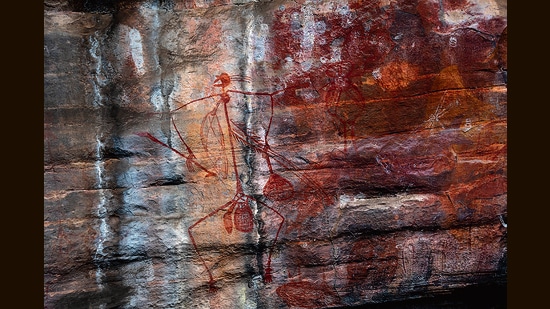It’s mid-afternoon in the Mary River wetlands. Located 150 km east of Darwin in the Northern Territory, Australia, the wetlands and billabongs here are visited by a profusion of bird life. Here, a wandering whistling duck. There, a green pygmy goose. Everywhere lotus lilies, kookaburras, jabiru or the black-necked stork, and saltwater crocodiles in groups of twos and threes.
It’s a 34-minute drive to the Kakadu National Park, where stony plateaus meet waterfalls and red cliffs. Several aboriginal clans still call the park home, making it a living cultural landscape. The park is also home to one of the largest concentrations of ancient rock art in the world, including the 20,000-year-old paintings at Ubirr.
Traditional paintings and the stories they narrate are part of the unwritten library of knowledge that the Aboriginal people have passed down over thousands of years. The Kakadu park’s logo, for instance, is a traditional painting of a rainbow serpent, believed to be a powerful ancestor who created passages through rocks, formed watering holes, and shaped the land for all living beings. My Aboriginal guide Tim says the image symbolises the serpent’s continued power and presence in the landscape, and the obligation of the Bininj / Mungguy clan that live here to care for the land as if it were a living entity.
Images on the rocks depict some of the Aboriginal people’s oldest memories and norms. These include lessons in how to care for the country and the self. There are drawings of figures armed with hooked sticks and boomerangs, defending the territory, and guarding against crocodile attacks. If a hunter was particularly proud of the size and condition of his catch, it was depicted on a rock wall too, so some drawings just show a perfect fish hanging from its tail.

See more images from Sonia Nazareth’s journey through the Northern Territory here
There are drawings of the thylacine or Tasmanian tiger (which went extinct in the 1930s). More recent drawings, from 500 years ago, depict humans carrying didgeridoos. There are even rock paintings of the white man, depicted as a figure with hands on hips.
A 250-metre rocky climb to the Nadab lookout offers views across the floodplain. “Now we place emphasis on wealth. Then we placed emphasis on skill,” Tim says.
A two-hour drive away, in the Litchfield National Park, waterfalls and gorges form the backdrop to the star attraction: giant magnetic termite mounds. The mounds are so named because their fronts all face north. From a distance, arranged as they are, they make the vast expanse look almost like a cemetery, except that each structure of soil, saliva and dung is up to two metres tall.
Brimming with natural wonders, the Top End of the Northern Territory is a biodiversity hotspot. Lodges, camping sites and towns such as Jabiru punctate expanses of savanna woodland, tidal mudflats, sandstone plateaus and forests of all permutations. Braving rocky slopes, befriending the frill-necked lizard, and steering clear of the crocodile, is the grand equaliser on any journey in these parts. But these challenges, navigated with the assistance of western scientific thought, traditional Aboriginal learning and respect for the land, make the journey greater than the sum of its parts.
Enjoy unlimited digital access with HT Premium
Subscribe Now to continue reading

Stay connected with us on social media platform for instant update click here to join our Twitter, & Facebook
We are now on Telegram. Click here to join our channel (@TechiUpdate) and stay updated with the latest Technology headlines.
For all the latest Art-Culture News Click Here
